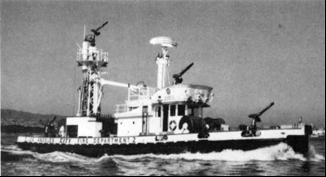The completion of a three year upgrading program for Fireboat 2 has provided this venerable dreadnaught with a tremendous improvement in performance and safety.
Over the years, the thought of packing 2,156 gallons of gasoline to waterfront fires has never been comforting to the men assigned to this floating fire department; but that is a thing of the past now, as the result of the outstanding efforts of the Shops, the mechanics and a handful of dedicated fire personnel. |

The "Ralph J. Scott" (better known as Fireboat 2) puts
to sea with new engines and the punch of a dozen
engine companies.
|
Boat 2 was on duty during the entire overhaul. This period encompassed numerous events including the Sansinena tanker fire. During one six-hour wharf fire, a pump engine was below deck suspended by chains as the boat swept up and down the wharf throughout the day.
Boat 2 was originally powered with seven 350 hp, 6 cylinder, in-line Winton engines. These were replaced in the late forties with five 275 hp, 6 cylinder, in-line Hall Scotts, and two 625 hp, V-12 Hall Scotts. The new diesel engines feature three 380 hp, 6 cylinder, in-line Cummins, two 525 hp, V-12, 2 cycle Detroits and two 700 hp, V-12 Cummins.
The conversion to diesel fuel represents a major improvement in safety, economy and dependability through the elimination of the more hazardous gasoline.
The new Twin Disc 3.5:1 reduction main drive transmissions provide for greater stopping power, replacing thirty-year-old planetary types which were restricted to 1000 rpm in reverse and occasionally slipped at critical moments.
For many years, the crews on Boat 2 have been subjected to a heavy barrage of noise and exhaust gases due to the water level unmufflered wet system formerly in use. This has been replaced by a high level dry exhaust system fully mufflered and heat and sound insulated. The three-inch insulation around each underdeck muffler and pipe consists of a 1 1/2" layer of heavy fiber glass matt, a thin layer of lead sheeting, another 1 1/2" layer of glass and an air-ball outer covering. The nine stacks range in size from 3 1/2" to 8" and are made of thin-wall aluminum to increase stability.
Tremendous credit must be given to all the people involved in this challenging program: to retired Jim Cosgrove; to Bob Finn, Clarence Blaine, Bob Berg, George Jordan and all the staff at Supply and Maintenance; to mechanics Kenny Bacon and Bob Farrier whose high level of craftsmanship guaranteed success; to sheetmetal men Carlos Pena and Jim Araki; to electricians Lyle Anderson and Bill Pickins and blacksmith Larry Boyd; to the men of Fire Station 112 on all platoons; and especially to the dedicated marine engineers assigned to Boat 2. These engineers represent a long line of diligent workers who have labored long hours to keep our fireboats constantly ready for action. They have never really received the credit due them for their sacrificial contributions to the Department. |
The program consisted of six major points:
1. Replacement of seven engines over thirty years old.
2. Conversion from gasoline to diesel fuel.
3. Installation of improved main drive transmissions.
4. Conversion from water level wet exhaust to high level
dry exhaust systems.
5. Noise level reduction through installation of mufflers
and sound proofing materials.
6. Improved intercommunication system between pilot
house, engine room and deck stations.
When work began on this project back in 1975, it was estimated that it would take about five years to complete; however as of July 27, 1978, exactly three years since the first engine was removed, the work is 98% completed.
The words "changing an engine" roll easily off the tongue, but the actual work necessary to accomplish this action was long and involved. Hatches, heavy deck structures and the engine room ladder had to be removed, as well as several other systems and structures including the "quiet room", a sound insulated engineer's station located in the engine room. After the old engine was dismantled and removed, these structures all had to be replaced, only to be removed again when the dismantled new engine was ready to install one piece at a time; then replace the structures again until the next engine was ready. Of course all the engine beds had to be prepared and altered to accommodate the new engine. 5000 pounds of ballast had to be brought aboard to keep the vessel trim and then moved with each major weight change.
Throw in modifications to the following systems: fuel, fresh and salt water cooling, electrical, air induction, pneumatic and hydraulic; multiply all this times seven and the immensity of this project becomes apparent.
Even more remarkable was the fat that with the exception of routine annual haul-outs and a few brief periods of thirty minutes or less, |